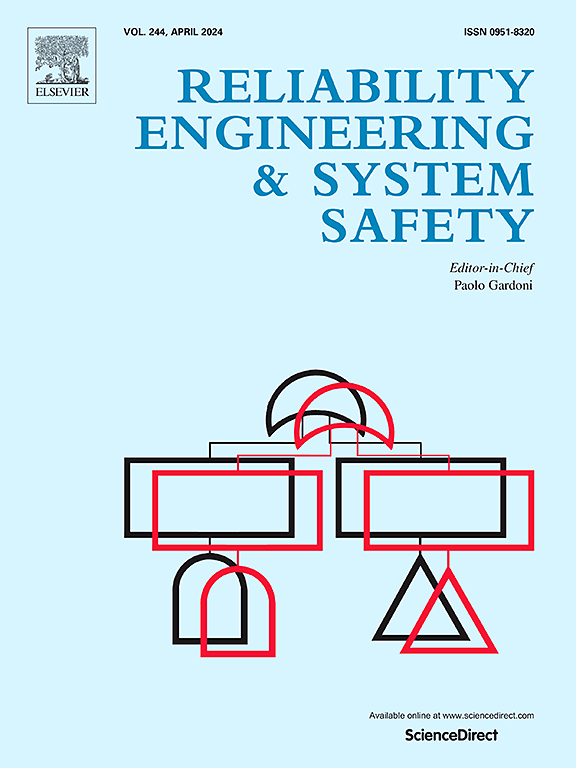数据驱动的地下管道腐蚀可靠性演化预测
IF 11
1区 工程技术
Q1 ENGINEERING, INDUSTRIAL
引用次数: 0
摘要
腐蚀对管道的结构完整性和使用寿命都是一个重大威胁。尽管现有模型可用于评估石油和天然气行业的腐蚀速率和管道可靠性,但其适用性受到周围土壤环境固有复杂性的限制。在这项研究中,开发了一种新的基于人工智能的混合模型来预测管道腐蚀速率。采用极限学习机(ELM)作为主要预测因子。将秃鹰搜索(Bald Eagle Search, BES)算法与lsamvy飞行搜索算法和模拟退火(simulation退火)算法进行整合和增强,形成LSBES算法,对ELM模型的参数学习进行优化。开发了三个机器学习模型作为基准来评估所提出的混合模型的性能。结果表明,LSBES-ELM模型具有较好的预测精度和稳定性,mAP接近95%,RE范围在0.0274 ~ 0.0761之间,优于基于基线ELM的模型(BES-ELM、ELM)和未优化的BP神经网络(BPNN)。在此基础上,将LSBES-ELM模型与蒙特卡罗模拟(Monte Carlo simulation, MCS)相结合,建立了LSBES-ELM-MCS模型,对不同埋地条件下管道腐蚀速率影响因素的最优分布进行了动态评估,并进行了可靠性演化预测。考虑到目标可靠性,预计管道的最佳检查间隔为21 ~ 24年。该研究有望为腐蚀管道可靠性建模提供重要意义,并有助于提高油气行业管道的安全性和使用寿命。本文章由计算机程序翻译,如有差异,请以英文原文为准。
Data-driven reliability evolution prediction of underground pipeline under corrosion
Corrosion presents a substantial threat to both the structural integrity and the service life of pipelines. Despite the availability of existing models for assessing corrosion rate and pipeline reliability in the oil and gas industry, their applicability is constrained by the inherent complexity of the surrounding soil environment. In this study, a novel artificial intelligence-based hybrid model was developed to predict pipeline corrosion rate. The Extreme Learning Machine (ELM) was employed as the primary predictor. The Bald Eagle Search (BES) algorithm was integrated and enhanced by incorporating Lévy flight search and Simulated annealing (SA) algorithms, forming the LSBES algorithm to optimize the parameter learning of the ELM model. Three machine learning models were developed as benchmarks to evaluate the performance of the proposed hybrid model. The results demonstrate that the LSBES-ELM model demonstrates superior predictive accuracy and stability, with a mAP of approaching 95 % and a RE ranging from 0.0274 to 0.0761, surpassing the performance of both baseline ELM-based models (BES-ELM, ELM) and the non-optimized BP Neural Network (BPNN). Furthermore, the LSBES-ELM-MCS model was developed with the LSBES-ELM model and Monte Carlo simulation (MCS) to perform a dynamic assessment of the optimal distribution of factors influencing corrosion rates and the reliability evolution prediction of pipelines with various buried soil conditions. With target reliability, the optimal inspection interval for the case pipeline was projected to fall between 21 and 24 years. This study is expected to present significance for modeling corroded pipeline reliability and contribute to the broader goal of enhancing pipeline safety and longevity in the oil and gas industry.
求助全文
通过发布文献求助,成功后即可免费获取论文全文。
去求助
来源期刊

Reliability Engineering & System Safety
管理科学-工程:工业
CiteScore
15.20
自引率
39.50%
发文量
621
审稿时长
67 days
期刊介绍:
Elsevier publishes Reliability Engineering & System Safety in association with the European Safety and Reliability Association and the Safety Engineering and Risk Analysis Division. The international journal is devoted to developing and applying methods to enhance the safety and reliability of complex technological systems, like nuclear power plants, chemical plants, hazardous waste facilities, space systems, offshore and maritime systems, transportation systems, constructed infrastructure, and manufacturing plants. The journal normally publishes only articles that involve the analysis of substantive problems related to the reliability of complex systems or present techniques and/or theoretical results that have a discernable relationship to the solution of such problems. An important aim is to balance academic material and practical applications.
 求助内容:
求助内容: 应助结果提醒方式:
应助结果提醒方式:


